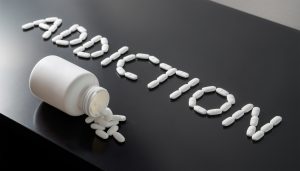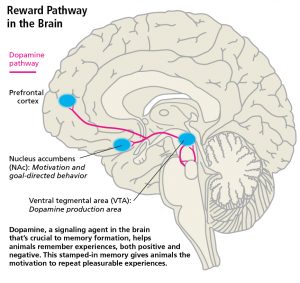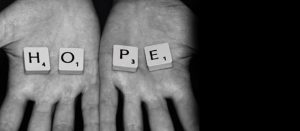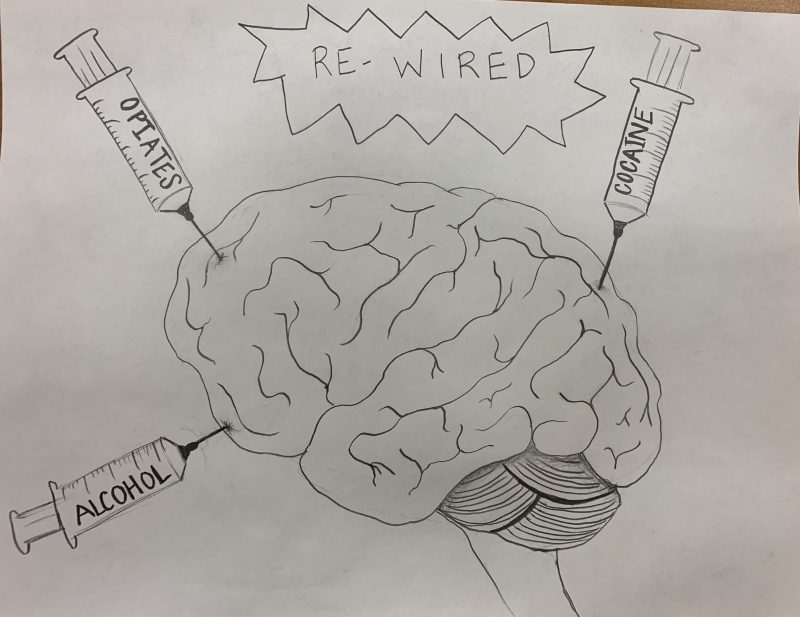Imagine yourself surrounded by a group of people wanting to try drugs in order to “fit in” and “be cool.” They ask if you want to try some and you feel pressured into saying yes because you keep thinking “I won’t get addicted” or “I’m going to try it just this once.” The next thing you know your body starts to feel different and you notice many changes in how you feel after taking the drug. You feel the need to constantly want more and the next time you get together with those friends who pressured you into trying the drug in the first place, you notice they don’t seem they need as much of the drug as you do to feel the “high.” This is addiction, and your life will forever be changed.

Figure 1.
Your Brain on Drugs
Often times in our society, the media portrays those who have an addiction as “junkies” or “low lives” and many people have the mentality towards addicts as “why can’t they just stop using drugs, it can’t be that hard to quit, it’s a personal choice” and the like. What many people don’t understand or realize is that the brain re-wires itself when in contact with drugs of addiction. The onset of addiction is also characterized by 50% genetic predisposition and 50% environmental factors so in the example above, you likely got addicted after your first exposure to the drug and your friends didn’t because of genetics or family history. Some of those friends may never form an addiction even after using multiple times. So yes, addiction could happen to anyone.
Reward Pathway
Dopamine is a neurotransmitter involved in the brain’s reward and motivation pathway. This neurotransmitter is released when we find something pleasurable such as drugs, alcohol, or food. There are two dopamine receptors that are very important to the addiction story: D1 and D2 receptors. D1 receptors are involved with direct activation of the reward pathway and have a lower binding affinity for dopamine, whereas D2 receptors are involved with indirect punishment and pathway inhibition and have a higher binding affinity for dopamine.

Figure 2.
Furthermore, there are important brain regions involved in the reward pathway and dopamine, namely the nucleus accumbens (NAc) and the ventral tegmental area (VTA). When you put drugs into your body, neurons in the VTA increase dopamine release from the NAc, which causes the activation of D1 and D2 receptors and gives you the “high” or euphoria feeling. Over a period of time, there is over-activation of dopamine and stimulation of the receptors involved which impairs the regulatory responses your brain is responsible for. Due to this impairment, your brain creates and strengthens the circuitry involved with other brain regions such as the hippocampus and amygdala that makes it nearly impossible to stop using the drugs. The results from these stronger neural circuits cause the brain to form behavioral memories that are associated with the drug use and pleasure that came with using those drugs. Therefore, the next time that you used drugs, your brain remembers when you took that drug before, where you took it, and this brings up more cravings for that drug.
 Figure 3.
Figure 3.
So, the next time you are surrounded with a group of people and they try pressuring you into taking something in which you do not know how your body will react physiologically, don’t fall victim to the “just this once” mentality and resist the pressure. It may be one of the hardest things you have to do, but your brain will thank you for it later.
Image 1: https://www.longevitylive.com/anti-aging-beauty/the-effects-of-addiction-explored/
Image 2: http://discovermagazine.com/2015/may/17-resetting-the-addictive-brain
Image 3: https://www.drugfoundation.org.nz/matters-of-substance/november-2014/ageing-out-of-addiction/
